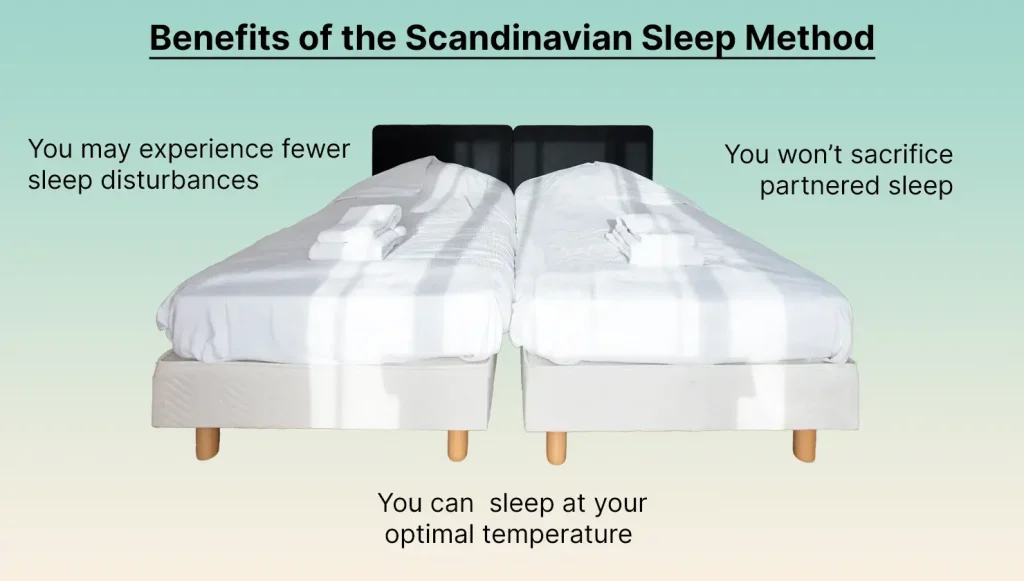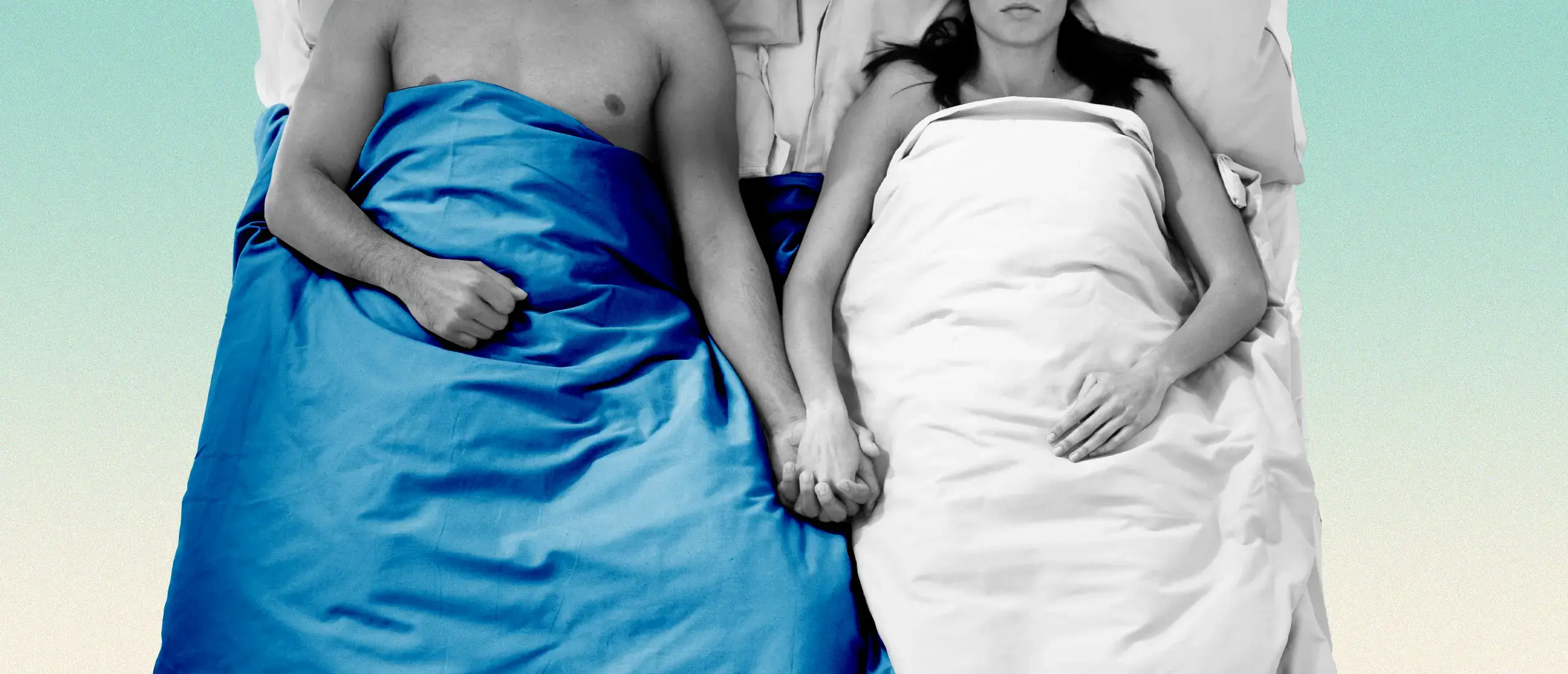The Scandinavian Sleep Method Could Improve Your Sleep—And Your Relationship
- By Rebekah Harding
- January 31, 2024
30-Second Takeaway
- The Scandinavian sleep method allows you to still sleep with your partner, but calls for separate bedding to reduce sleep disturbances.
- Having separate top sheets and covers can improve sleep quality by allowing each partner to customize to their sleep preferences.
- Sleep disturbances decrease deep sleep quality, which may contribute to chronic disease risk.
S
Sleep is critical for overall health, and yet adults in the United States don’t get nearly enough of it. Could your current sleeping arrangement with your partner be to blame (1)? And could the Scandinavian sleep method help?
Couples who are tired of fighting over the covers are taking action to resolve their sleep-disrupting tussles. According to a survey released last month by the American Academy of Sleep Medicine, one third of couples opted for a “sleep divorce,” meaning both partners have their own bed or sleep space (2).
But the Scandinavian sleep method may be the solution for couples in need of better quality Zs—and it doesn’t call for a bedroom breakup.
What is the Scandinavian Sleep Method?
The Scandinavian sleep method—popularized in countries like Sweden, Denmark, and Norway—is simple: You and your bed partner sleep on the same mattress and fitted sheet, but with separate top bedding (duvets, sheets, blankets).
One potential downside to this method is that you’ll have to wash twice the amount of bedding—but for better sleep, it might be worth the extra laundry.
Should I Try It?
“The Scandinavian sleep method is best for people who sleep in the same bed with a partner, but who may be easily disturbed by their partner’s movement at night,” says neuroscientist Chelsie Rohrscheib, Ph.D.
However, this method won’t remedy all bed-sharing problems. If your partner struggles with snoring or uses a CPAP machine for sleep apnea, the noise may still disturb your Zs. In that case, you may want to snag some sleep-safe noise-canceling earbuds.
This method may also prove difficult if you’re splitting a smaller mattress, as double duvets may not fit on the bed.
About the Expert:
Chelsie Rohrscheib, Ph.D., is a neuroscientist and sleep expert at Wesper, a sleep testing company. She specializes in sleep apnea and sleep genetics, and provides sleep consultations.
Scandinavian Sleep Method Benefits
Fewer sleep disturbances
If you’re in a relationship, you know a restful night of sleep can easily be interrupted by a heated battle for the covers. Or, maybe your partner routinely twists and turns in their sleep, ripping you out of toasty warmth and making it nearly impossible to get quality shuteye.
“Tugging on blankets can be very disruptive to sleep for some people,” Rohrscheib says. “The Scandinavian sleep method reduces sleep disturbances when one partner is moving or changing positions.”
These seemingly small sleep disruptions come with big health consequences. According to a 2017 review published in Nature and Science of Sleep (3), disrupted sleep can impact your stress response and make you cranky in the short-term.
Long term, sleep disturbances can contribute to your risk of cardiovascular disease, weight-related issues, metabolic syndrome, and type 2 diabetes. This is because regular disturbances can interrupt restorative sleep—called deep sleep—which plays a role in memory and cognitive function, hormone health, and overall well-being (4, 5).
You keep the benefits of partnered sleep
The Scandinavian sleep method still allows you to be in close proximity to your partner. While opting for separate beds can be tempting, sleeping in the same bed together may offer its own set of health benefits.
Research shows that snuggling your partner may decrease cortisol (stress hormone) and blood pressure, which can improve your stress levels and sleep quality (6). Just remember to curl up in your separate set of top covers when it’s time for sleep.
Bed-sharing with your partner may even improve REM sleep, a deep stage of the sleep cycle that supports brain function and emotional processing. According to a 2020 study, co-sleeping resulted not only in a 10 percent increase in REM, but also less fragmented REM overall (7).
You can sleep at your optimal temperature
While sleeping in cooler temperatures—specifically between 60 and 68 degrees Fahrenheit— can actually improve your sleep quality (8), sudden bursts of cold air (from a sheet being torn off your body) can easily pull you out of your sleep cycle.
Plus, partners often have different temperature preferences for sleep, according to the Sleep Foundation (9). A partner who runs hot can choose a thinner duvet and sleepers who prefer more warmth can layer accordingly. No compromise needed.

How to Try the Scandinavian Sleep Method
Choose the right bedding
“Instead of using one large blanket or comforter, each partner should select a smaller blanket that suits them,” Rohrscheib says. “Ideally, the blanket will be large enough to sleep comfortably, but not large enough to take over the entire bed.”
While most Scandinavian sleepers opt for two twin comforters, one Redditor in r/IKEA suggests picking up two twin XL comforters if you have a queen or king-sized mattress. This size provides additional vertical length, allowing the duvet to reach the end of the bed.
Pick the best material
Do you ever wake up in the middle of the night with the sweats? Or, do you shiver uncontrollably when the room drops below 70 degrees? To get the most out of the Scandinavian sleep method, you’ll want to select duvet covers that work with your individual sleep preferences.
A self-described hot sleeper on r/Bedding recommends lightweight cotton sheets and a linen duvet. They also avoid all plastic-based material, which they found traps heat and contributes to nighttime sweats. Another Redditor recommends a natural wool duvet insert to add an extra layer of insulation for cold sleepers.
References
1. Centers for Disease Control and Prevention (CDC). Sleep and Sleep Disorders.
2. American Academy of Sleep Medicine (AASM). Over a third of Americans opt for a “sleep divorce”
3. Medic, et al (2017). Short- and long-term health consequences of sleep disruption.
4. Ulrich (2016). Sleep Spindles as Facilitators of Memory Formation and Learning.
5. Shaw, et al (2015). Accumulated Deep Sleep Is a Powerful Predictor of LH Pulse Onset in Pubertal Children.
6. Sumioka, et al (2013). Huggable communication medium decreases cortisol levels.
7. Drews, et al (2020). Bed-Sharing in Couples Is Associated With Increased and Stabilized REM Sleep and Sleep-Stage Synchronization.
8. Sleep Foundation (2023). Best Temperature for Sleep
9. Sleep Foundation (2023). What Is the Scandinavian Sleep Method and What Are Its Benefits?











